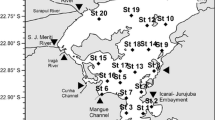Abstract
A method is described for the incubation of undisturbed sediment cores under in situ conditions with the addition of low concentrations of 14C-glucose. Data are presented for respiration, gross uptake and actual uptake rate of glucose by bacteria in sandy, wave-washed beaches of the Baltic Sea. On the average, the bacteria respired 8% of the total glucose taken up. The gross uptake measured was between 2.3×10-3 and 6.8×10-3 μg 14C-glucose g sediment-1 (dry weight) h-1 (average 4.7×10-3 μg g-1 h-1). Minima in the gross uptake rate corresponded with maxima in the concentration of natural free dissolved glucose. For the actual uptake rate, however, very similar uptake rates were calculated for the sediments examined (between 1.4×10-1 and 1.9×10-1 μg glucose g-1 h-1, average 1.7×10-1 μg g-1 h-1).
Similar content being viewed by others
Literature Cited
Griffiths, R.P., F.J. Hanus and R.Y. Morita: The effects of various water-sample treatments on the apparent uptake of glutamic acid by natural marine microbial populations. Can. J. Microbiol. 20, 1261–1266 (1974)
Hall, K.J., P.M. Kleiber and I. Yesaki: Heterotrophic uptake of organic solutes by micro-organisms in the sediment. Memorie Ist. ital. Idrobiol. 29 (Suppl.), 441–471 (1972)
Hargrave, B.T.: Aerobic decomposition of sediment and detritus as a function of particle surface area and organic content. Limnol. Oceanogr. 17, 583–596 (1972)
Harrison, M.J., R.T. Wright and R.Y. Morita: Method for measuring mineralization in lake sediments. Appl. Microbiol. 21, 698–702 (1971)
Hobbie, J.E. and C.C. Crawford: Respiration corrections for bacterial uptake of dissolved organic compounds in natural waters. Limnol. Oceanogr. 14, 528–532 (1969)
Jeffay, H. and J. Alvarez: Liquid scintillation counting of carbon-14. Use of ethanolamine-ethylene glycol monomethyl ether-toluene. Analyt. Chem. 33, 612–615 (1961)
Lerman, A. and T.A. Lietzke: Uptake and migration of tracers in lake sediments. Limnol. Oceanogr. 20, 497–510 (1975)
Van Slyke, D.D., J. Plazin and J.R. Weisiger: Reagents for the Van Slyke-Folch wet carbon combustion. J. biol. Chem. 191, 299–304 (1951)
Williams, P.J. LeB.: Heterotrophic utilization of dissolved organic compounds in the sea. I. Size distribution of population and relationship between respiration and incorporation of growth substrates. J. mar. biol. Ass. U.K. 50, 859–870 (1970)
Wood, L.W.: The role of estuarian sediment micro-organisms in the uptake of organic solutes under aerobic conditions, 75 pp. Ph. D. Thesis, North Carolina State University at Raleigh 1970
Author information
Authors and Affiliations
Additional information
Communicated by O. Kinne, Hamburg
Publication No. 183 of the “Joint Research Program” at Kiel University (Sonderforschungsbereich 95 der Deutschen Forschungsgemeinschaft).
Rights and permissions
About this article
Cite this article
Meyer-Reil, LA. Uptake of glucose by bacteria in the sediment. Mar. Biol. 44, 293–298 (1978). https://doi.org/10.1007/BF00390892
Accepted:
Issue Date:
DOI: https://doi.org/10.1007/BF00390892




